Book contents
- Frontmatter
- Dedication
- Contents
- Preface and outline
- 1 Introduction
- 2 Statistical mechanics: A modern review
- 3 The complexity of minimalistic lattice models for protein folding
- 4 Monte Carlo and chain growth methods for molecular simulations
- 5 First insights to freezing and collapse of flexible polymers
- 6 Crystallization of elastic polymers
- 7 Structural phases of semiflexible polymers
- 8 Generic tertiary folding properties of proteins on mesoscopic scales
- 9 Protein folding channels and kinetics of two-state folding
- 10 Inducing generic secondary structures by constraints
- 11 Statistical analyses of aggregation processes
- 12 Hierarchical nature of phase transitions
- 13 Adsorption of polymers at solid substrates
- 14 Hybrid protein–substrate interfaces
- 15 Concluding remarks and outlook
- References
- Index
9 - Protein folding channels and kinetics of two-state folding
Published online by Cambridge University Press: 05 May 2014
- Frontmatter
- Dedication
- Contents
- Preface and outline
- 1 Introduction
- 2 Statistical mechanics: A modern review
- 3 The complexity of minimalistic lattice models for protein folding
- 4 Monte Carlo and chain growth methods for molecular simulations
- 5 First insights to freezing and collapse of flexible polymers
- 6 Crystallization of elastic polymers
- 7 Structural phases of semiflexible polymers
- 8 Generic tertiary folding properties of proteins on mesoscopic scales
- 9 Protein folding channels and kinetics of two-state folding
- 10 Inducing generic secondary structures by constraints
- 11 Statistical analyses of aggregation processes
- 12 Hierarchical nature of phase transitions
- 13 Adsorption of polymers at solid substrates
- 14 Hybrid protein–substrate interfaces
- 15 Concluding remarks and outlook
- References
- Index
Summary
Folding of linear chains of amino acids, i.e., bioproteins and synthetic peptides, is, for single-domain macromolecules, accompanied by the formation of secondary structures (helices, sheets, turns) and the tertiary hydrophobic-core collapse. While secondary structures are typically localized and thus limited to segments of the peptide, the effective hydrophobic interaction between nonbonded, nonpolar amino acid side chains results in a global, cooperative arrangement favoring folds with compact hydrophobic core and a surrounding polar shell that screens the core from the polar solvent. Systematic analyses for unraveling general folding principles are extremely difficult in microscopic all-atom approaches, since the folding process is strongly dependent on the “disordered” sequence of amino acids and the native-fold formation is inevitably connected with, at least, significant parts of the sequence. Moreover, for most proteins, the folding process is relatively slow (microseconds to seconds), which is due to a complex, rugged shape of the freeenergy landscape [190–192] with “hidden” barriers, depending on sequence properties. Although there is no obvious system parameter that allows for a general description of the accompanying conformational transitions in folding processes (as, for example, the reaction coordinate in chemical reactions), it is known that there are only a few characteristic folding behaviors known, such as two-state folding, folding through intermediates, and glass-like folding into metastable conformations [193–199].
Thus, if a classification of folding characteristics is useful at all, strongly simplified coarse-grained models should allow to describe generic statistical [46,47] and kinetic [200] pseudo-universal properties.
- Type
- Chapter
- Information
- Publisher: Cambridge University PressPrint publication year: 2014



